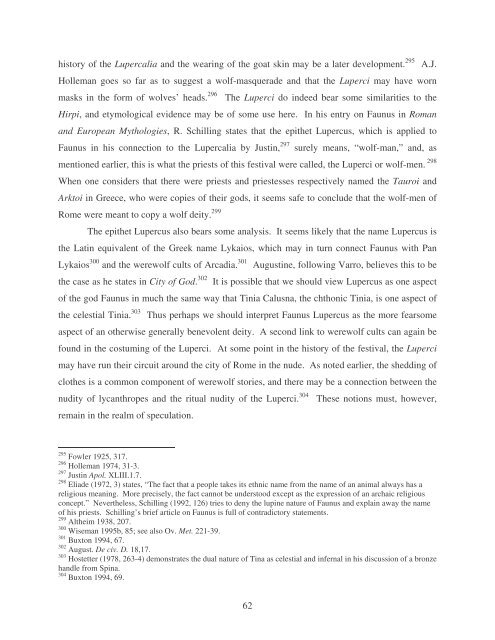Final Draft - Preview Matter - Florida State University
Final Draft - Preview Matter - Florida State University
Final Draft - Preview Matter - Florida State University
Create successful ePaper yourself
Turn your PDF publications into a flip-book with our unique Google optimized e-Paper software.
history of the Lupercalia and the wearing of the goat skin may be a later development. 295 A.J.<br />
Holleman goes so far as to suggest a wolf-masquerade and that the Luperci may have worn<br />
masks in the form of wolves’ heads. 296 The Luperci do indeed bear some similarities to the<br />
Hirpi, and etymological evidence may be of some use here. In his entry on Faunus in Roman<br />
and European Mythologies, R. Schilling states that the epithet Lupercus, which is applied to<br />
Faunus in his connection to the Lupercalia by Justin, 297 surely means, “wolf-man,” and, as<br />
mentioned earlier, this is what the priests of this festival were called, the Luperci or wolf-men. 298<br />
When one considers that there were priests and priestesses respectively named the Tauroi and<br />
Arktoi in Greece, who were copies of their gods, it seems safe to conclude that the wolf-men of<br />
Rome were meant to copy a wolf deity. 299<br />
The epithet Lupercus also bears some analysis. It seems likely that the name Lupercus is<br />
the Latin equivalent of the Greek name Lykaios, which may in turn connect Faunus with Pan<br />
Lykaios 300 and the werewolf cults of Arcadia. 301 Augustine, following Varro, believes this to be<br />
the case as he states in City of God. 302 It is possible that we should view Lupercus as one aspect<br />
of the god Faunus in much the same way that Tinia Calusna, the chthonic Tinia, is one aspect of<br />
the celestial Tinia. 303 Thus perhaps we should interpret Faunus Lupercus as the more fearsome<br />
aspect of an otherwise generally benevolent deity. A second link to werewolf cults can again be<br />
found in the costuming of the Luperci. At some point in the history of the festival, the Luperci<br />
may have run their circuit around the city of Rome in the nude. As noted earlier, the shedding of<br />
clothes is a common component of werewolf stories, and there may be a connection between the<br />
nudity of lycanthropes and the ritual nudity of the Luperci. 304 These notions must, however,<br />
remain in the realm of speculation.<br />
295<br />
Fowler 1925, 317.<br />
296<br />
Holleman 1974, 31-3.<br />
297<br />
Justin Apol. XLIII.1.7.<br />
298<br />
Eliade (1972, 3) states, “The fact that a people takes its ethnic name from the name of an animal always has a<br />
religious meaning. More precisely, the fact cannot be understood except as the expression of an archaic religious<br />
concept.” Nevertheless, Schilling (1992, 126) tries to deny the lupine nature of Faunus and explain away the name<br />
of his priests. Schilling’s brief article on Faunus is full of contradictory statements.<br />
299<br />
Altheim 1938, 207.<br />
300<br />
Wiseman 1995b, 85; see also Ov. Met. 221-39.<br />
301<br />
Buxton 1994, 67.<br />
302<br />
August. De civ. D. 18,17.<br />
303<br />
Hostetter (1978, 263-4) demonstrates the dual nature of Tina as celestial and infernal in his discussion of a bronze<br />
handle from Spina.<br />
304 Buxton 1994, 69.<br />
62

















